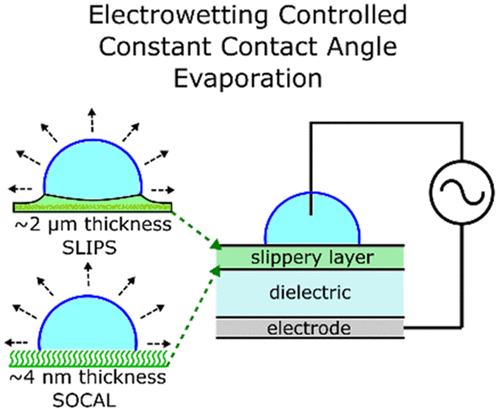Our official English website, www.x-mol.net, welcomes your feedback! (Note: you will need to create a separate account there.)
Evaporation and Electrowetting of Sessile Droplets on Slippery Liquid-Like Surfaces and Slippery Liquid-Infused Porous Surfaces (SLIPS).
Langmuir ( IF 3.9 ) Pub Date : 2020-09-03 , DOI: 10.1021/acs.langmuir.0c02020 S Armstrong 1, 2 , G McHale 1, 2 , R Ledesma-Aguilar 1, 2 , G G Wells 1, 2
Langmuir ( IF 3.9 ) Pub Date : 2020-09-03 , DOI: 10.1021/acs.langmuir.0c02020 S Armstrong 1, 2 , G McHale 1, 2 , R Ledesma-Aguilar 1, 2 , G G Wells 1, 2
Affiliation

|
Sessile droplet evaporation underpins a wide range of applications from inkjet printing to coating. However, drying times can be variable and contact-line pinning often leads to undesirable effects, such as ring stain formation. Here, we show voltage programmable control of contact angles during evaporation on two pinning-free surfaces. We use an electrowetting-on-dielectric approach and Slippery Liquid-Infused Porous (SLIP) and Slippery Omniphobic Covalently Attached Liquid-Like (SOCAL) surfaces to achieve a constant contact angle mode of evaporation. We report evaporation sequences and droplet lifetimes across a broad range of contact angles from 105°–67°. The values of the contact angles during evaporation are consistent with expectations from electrowetting and the Young-Lippman equation. The droplet contact areas reduce linearly in time, and this provides estimates of diffusion coefficients close to the expected literature value. We further find that the total time of evaporation over the broad contact angle range studied is only weakly dependent on the value of the contact angle. We conclude that on these types of slippery surfaces, droplet lifetimes can be predicted and controlled by the droplet’s volume and physical properties (density, diffusion coefficient, and vapor concentration difference to the vapor phase) largely independent of the precise value of contact angle. These results are relevant to applications, such as printing, spraying, coating, and other processes, where controlling droplet evaporation and drying is important.
中文翻译:

滑状液体表面和滑润性液体多孔表面(SLIPS)上无滴的蒸发和电润湿。
无数液滴的蒸发为从喷墨印刷到涂料的广泛应用奠定了基础。但是,干燥时间可以变化,接触线钉扎通常会导致不良后果,例如形成环斑。在这里,我们显示了两个无销钉表面上蒸发过程中接触角的电压可编程控制。我们使用电介质上的电润湿方法以及湿滑注液多孔(SLIP)和湿滑疏液共价附着的液体样(SOCAL)表面来实现恒定的接触角蒸发模式。我们报告了从105°–67°的宽接触角范围内的蒸发序列和液滴寿命。蒸发过程中的接触角值与电润湿和Young-Lippman方程的期望值一致。液滴接触面积随时间线性减小,这提供了接近预期文献值的扩散系数估计。我们进一步发现,在所研究的宽接触角范围内蒸发的总时间仅微弱地取决于接触角的值。我们得出结论,在这些类型的光滑表面上,液滴的寿命可以通过液滴的体积和物理性质(密度,扩散系数和气相中的蒸气浓度差)来预测和控制,而很大程度上与接触角的精确值无关。这些结果与应用有关,例如印刷,喷涂,涂布和其他过程,在这些过程中,控制液滴的蒸发和干燥很重要。我们进一步发现,在所研究的宽接触角范围内蒸发的总时间仅微弱地取决于接触角的值。我们得出结论,在这些类型的光滑表面上,液滴的寿命可以通过液滴的体积和物理性质(密度,扩散系数和气相中的蒸气浓度差)来预测和控制,而很大程度上与接触角的精确值无关。这些结果与应用有关,例如印刷,喷涂,涂布和其他过程,在这些过程中,控制液滴的蒸发和干燥很重要。我们进一步发现,在所研究的宽接触角范围内蒸发的总时间仅微弱地取决于接触角的值。我们得出结论,在这些类型的光滑表面上,液滴的寿命可以通过液滴的体积和物理性质(密度,扩散系数和气相中的蒸气浓度差)来预测和控制,而很大程度上与接触角的精确值无关。这些结果与应用有关,例如印刷,喷涂,涂布和其他过程,在这些过程中,控制液滴的蒸发和干燥很重要。液滴的寿命可以通过液滴的体积和物理性质(密度,扩散系数和气相中的蒸气浓度差)来预测和控制,而很大程度上与接触角的精确值无关。这些结果与应用有关,例如印刷,喷涂,涂布和其他过程,在这些过程中,控制液滴的蒸发和干燥很重要。液滴的寿命可以通过液滴的体积和物理性质(密度,扩散系数和气相中的蒸气浓度差)来预测和控制,而很大程度上与接触角的精确值无关。这些结果与应用有关,例如印刷,喷涂,涂布和其他过程,在这些过程中,控制液滴的蒸发和干燥很重要。
更新日期:2020-09-29
中文翻译:

滑状液体表面和滑润性液体多孔表面(SLIPS)上无滴的蒸发和电润湿。
无数液滴的蒸发为从喷墨印刷到涂料的广泛应用奠定了基础。但是,干燥时间可以变化,接触线钉扎通常会导致不良后果,例如形成环斑。在这里,我们显示了两个无销钉表面上蒸发过程中接触角的电压可编程控制。我们使用电介质上的电润湿方法以及湿滑注液多孔(SLIP)和湿滑疏液共价附着的液体样(SOCAL)表面来实现恒定的接触角蒸发模式。我们报告了从105°–67°的宽接触角范围内的蒸发序列和液滴寿命。蒸发过程中的接触角值与电润湿和Young-Lippman方程的期望值一致。液滴接触面积随时间线性减小,这提供了接近预期文献值的扩散系数估计。我们进一步发现,在所研究的宽接触角范围内蒸发的总时间仅微弱地取决于接触角的值。我们得出结论,在这些类型的光滑表面上,液滴的寿命可以通过液滴的体积和物理性质(密度,扩散系数和气相中的蒸气浓度差)来预测和控制,而很大程度上与接触角的精确值无关。这些结果与应用有关,例如印刷,喷涂,涂布和其他过程,在这些过程中,控制液滴的蒸发和干燥很重要。我们进一步发现,在所研究的宽接触角范围内蒸发的总时间仅微弱地取决于接触角的值。我们得出结论,在这些类型的光滑表面上,液滴的寿命可以通过液滴的体积和物理性质(密度,扩散系数和气相中的蒸气浓度差)来预测和控制,而很大程度上与接触角的精确值无关。这些结果与应用有关,例如印刷,喷涂,涂布和其他过程,在这些过程中,控制液滴的蒸发和干燥很重要。我们进一步发现,在所研究的宽接触角范围内蒸发的总时间仅微弱地取决于接触角的值。我们得出结论,在这些类型的光滑表面上,液滴的寿命可以通过液滴的体积和物理性质(密度,扩散系数和气相中的蒸气浓度差)来预测和控制,而很大程度上与接触角的精确值无关。这些结果与应用有关,例如印刷,喷涂,涂布和其他过程,在这些过程中,控制液滴的蒸发和干燥很重要。液滴的寿命可以通过液滴的体积和物理性质(密度,扩散系数和气相中的蒸气浓度差)来预测和控制,而很大程度上与接触角的精确值无关。这些结果与应用有关,例如印刷,喷涂,涂布和其他过程,在这些过程中,控制液滴的蒸发和干燥很重要。液滴的寿命可以通过液滴的体积和物理性质(密度,扩散系数和气相中的蒸气浓度差)来预测和控制,而很大程度上与接触角的精确值无关。这些结果与应用有关,例如印刷,喷涂,涂布和其他过程,在这些过程中,控制液滴的蒸发和干燥很重要。



























 京公网安备 11010802027423号
京公网安备 11010802027423号